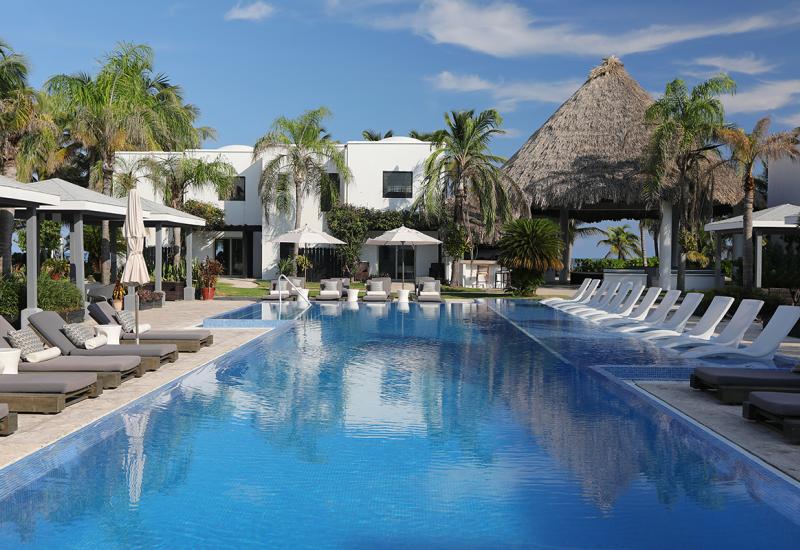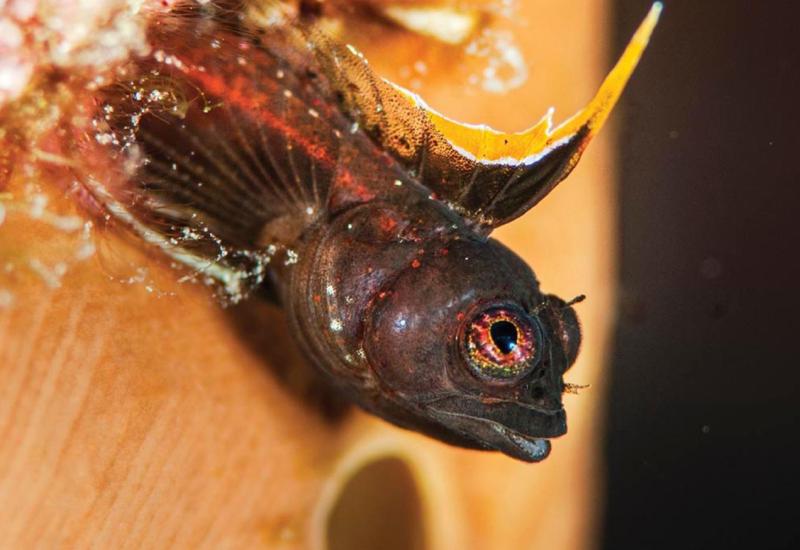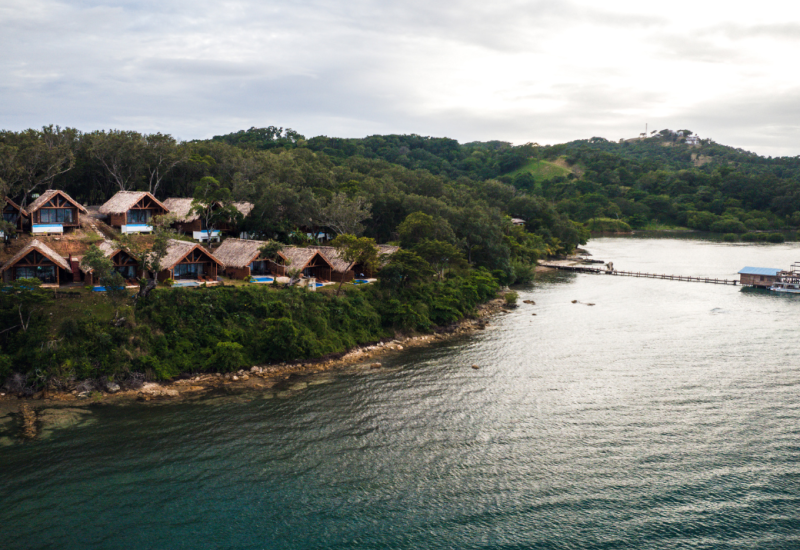Wild Side Diving in the Caribbean
On the windward side of these eight Caribbean islands, the ocean can pack a wicked punch — but when conditions are right, divers will find sites that are unknown, unexpected — and unmatched.
Go to a restaurant often enough, and you’ll find that sometimes, the chef tinkers with the menu. Chances are it’ll be good, or at least different. A surprise. And so it is with diving. We have our go-to favorite locales, but sometimes we want the guide to take us to a little-visited location. Or a site the crew doesn’t feel comfortable taking just anyone to. Often, it’ll be somewhere near open sea, where strong currents and serious surface swell collide. It’s an ocean wilderness that offers terrific odds of seeing something impressive. Like that unexpected entree, it’s diving that’s not always on the menu. Quite the rush indeed.
GRENADA
“You go down fighting the whole way,” says Peter Seupel, co-owner of Aquanauts dive shop, of what it’s like to descend into the currents that charge overtop the wreck of the 240-foot King Mitch, 4 miles off Grenada. “You find a place to hold on, and then it’s like a movie theater — you just watch the show.” And that show tends to be eagle rays. “It’s a cleaning station for them, so while you see two or three elsewhere on-island, here you see 20 cruising round you.” The cargo hold, which still contains much of the goods that once caused the vessel to sink, now shelters schools of fish. Also out in the Atlantic is the Hema 1, a cargo vessel that was overloaded, causing it to sink in 110 feet of water. Thanks to a 2005 hurricane, the ship is sliced in two. But Seupel says that’s a benefit. “The current likes to run through that gap between bow and stern, and so do the sharks and eagle rays.”
IN ANY WEATHER The massive M/V Bianca C, a 600-foot former passenger ship, is divable year-round. Although you might not see the bottom when you drop down, you’ll at least be able to do a free descent.
aquanautsgrenada.com
U.S. VIRGIN ISLANDS
“My most memorable dive on Carval Rock was a day that we had a few cancellations — it was just me and one other diver,” says Travis Krueger, instructor at Red Hook Dive Center on St. Thomas. Krueger says the islet (also spelled Carvel Rock) is the most exciting site visited by his outfit. The sheer-walled formation sits a mile and a half of the island’s north side, smack amid the Atlantic Ocean. “We didn’t swim anywhere, but just sat in one spot and watched hundreds of fish swirling overhead.” The site, due to its location, is best accessed in summer, but if reached in winter is an ideal spot for hearing whale song. Regardless of season, it’s a hot spot for marine life. Says Krueger: “It’s common to see dozens and dozens of tarpon, snapper, schooling jacks and king mackerel feeding.” And while the occasional shark is sighted, the locale isn’t known for pelagics — but did at one time attract much-larger passersby. The rock’s twin peaks resemble sails, or so allegedly thought the pirates who once fixed lanterns on them to lure boats to crash into it. More trivia: Competitors in The Amazing Race 25 climbed across the top of the rock before jumping into the ocean.
In Any Weather Congo Cay is divable year-round because you start the dive on the protected side, then make your way over to the wall. Says Krueger, "You ease into it, but then it's an in-your-face-wall."
redhookdivecenter.com
PETIT ST. VINCENT
“I saw Sail Rock every time I flew in from Barbados,” says Don Santee, co-owner of Jean-Michel Cousteau Diving Caribbean. He opened the shop this past November on Petit St. Vincent, a privately owned island in the St. Vincent and the Grenadines chain. His first order of business: Scout and explore dive sites. Sail Rock — the exposed feature jutting from the Atlantic along the island’s windward northeast coast — proved most enticing. “There’s so much current that whatever grows there is on a small scale.” That is, except for fish. It’s where Santee has seen the area’s biggest sharks and schools of snapper, and the greatest diversity of color. But it’s also the most challenging site. “The currents carry you laterally, and up and down.” The unpredictable currents don’t deter Santee. “It turned out to be our best site so far,” he says. “Before we set up shop, the other local operators weren’t diving it; now, they all are.”
In Any Weather Santee recommends diving the Tobago Cays and Mayreau Reef, which are also located in the Atlantic but provide more protection from currents.
jeanmichelcousteaudiving-caribbean.com
BONAIRE
“It looks intimidating from shore,” says Bas Tol, a private dive guide based on Bonaire. He’s talking about a site called Boka Spelonk, found along the elbow of the island’s east side, the opposite coast of where most shore divers park their rental pickups. “The entry is steep ironshore, and people say, ‘How the hell am I going to get in?’” The trick is knowing which rock to crouch behind as crashing waves come in. On the return to shore, this same wave-break creates pools of foam on the surface, adding drama. In between, Tol says you’ll see more turtles than anywhere else on-island. Boka Spelonk also packs species of small stuff not found on the west coast. It adds up to an experience that Tol calls the most exciting on-island. The area can be visited year-round, as long as conditions permit — a constant southeasterly wind blows in, and sometimes the waves are too huge to permit diving. Tol says accessing these sites depends even more on the divers, and their gear. He won’t take someone who doesn’t have good booties and a full wetsuit. Says Tol, “This diving is serious, but when wind picks up, it’s extra serious.”
In Any Weather The wreck of Hilma Hooker, a freighter with a colorful history of illegal drug running, is accessible from shore. Divers may find tarpon and territorial sergeant majors guarding their nests. buddydive.com
COZUMEL
Guillermo Mendoza has spent 25 years diving the island of Cozumel — and the past five looking for an area that’s local legend. Since the mid-’70s, neighboring Isla Mujeres was famous for caves of sleeping Caribbean reef sharks, until an influx of divers scared them of.
“I knew they had resettled somewhere close,” says the co-founder of Aldora Divers. In February 2014, Mendoza found it: six caves, all approximately 6 nautical miles from Cozumel’s northeast tip. “I almost cried,” he says. The caves vary in depth from 80 to 110 feet, and inside, on a good day, Mendoza has laid beside four sharks. “It’s peaceful to watch their gills, and the remoras cleaning their bodies,” he says. The area is reachable only when winds die to less than 10 knots, and waves are no higher than 3 feet. Mendoza says February to June is the best time of year for seeing the greatest number of sharks.
In this virgin oceanscape, there’s always a chance of encountering an eagle ray hunting crustaceans.
In Any Weather Aldora Divers specializes in dicing the island's northeast tip, and the eastern side. There, one of the more unique dives is an unidentified Spanish galleon with 17 cannons and countless cannonballs — but good luck finding the ammo. "I hide them after every dive so nobody's tempted to take them off-island," Mendoza says. But he is also quick to uncover them so divers can hold and feel the history contained in just 8 pounds.
aldora.com
TOBAGO
On Tobago, there’s a site called Heart Attack, named by a visiting Italian who deemed the reef one of the best adrenaline inducers he’d experienced. “It starts with a negative entry,” says Sean Robinson, owner of Tobago Dive Experience, of the Atlantic Ocean spot. And by that, he means you purge all air from your BC before rolling of the boat into the 4-knot current. “You point your head down, then when you reach the rock formations, you hold on — it’s pretty wild,” he says. The maximum depth is 110 feet, and the area, best visited June through October, is the cruising grounds of everything from mantas to whale sharks. As for the Italian diver, he kept encountering sharks. Says Robinson, “Wherever he turned, a big reef shark was swimming up in his face.”
Another open Atlantic Ocean site that quickens the pulse is called Washing Machine. “The currents form a vortex that spins you around and pulls you down,” says Robinson. “For an experienced diver, it’s the wildest roller coaster that you’ve ever been on, and it’s all fun as long as you don’t panic.”
In Any Weather Dive Shark Bank, and you're following an underwater mountain range from 110 to 50 feet. Says Robinson, "The chances are good you'll see pelagics — there's tremendous marine life."
tobagodiveexperience.com
CONCEPTION ISLAND, BAHAMAS
“We call it Heaven; it’s challenging to get to in that it has to be the right day, right current, right weather to dive,” says Dan Doyle, captain of the R/V Sea Dragon liveaboard, which visits the hard-to-reach south side — the windward side — of Conception Island in the summer months. The Atlantic Ocean site Doyle speaks of is listed on maps as Tunnel Heaven, a drop-of starting at 70 feet. “It’s a series of tunnels that look like teeth,” he says. Inside the tunnels,hulking goliath grouper stand guard. Outside, lucky divers may encounter the odd hammerhead or tiger shark cruising past. As is true throughout the Bahamas, “you see Caribbean reef sharks any time you want to dive the site,” says Doyle. Another plus: The island’s center is a large mangrove and creek habitat, which serves as an important nursery for fish. The island enjoys another advantage: “The marine life gets so much bigger because commercial fishermen don’t reach these areas,” says Doyle. That marine life includes sponges of gigantic proportions, and pristine black corals and sea fans.
In Any Weather If you can't dive the south wall, you can put in along the island's shallower western wall, where the corals grow much bigger and the visibility can exceed 100 feet or greater.
seadragonbahamas.com
BRITISH VIRGIN ISLANDS
“The best dive in the whole British Virgin Islands isn’t the Rhone, but the Chikuzen,” says Duncan Muirhead, owner of the S/Y Cuan Law, a trimaran customized for weeklong dive trips in the Caribbean island chain. The Chikuzen, a 246-foot former refrigeration ship, lies roughly 10 miles northeast of Virgin Gorda and is best reached in summer months. “It’s such a good dive site because it’s surrounded by sand desert — it’s the only habitat for miles,” Muirhead says. Nurse sharks, schools of amberjack, and cobia take notice, swirling constantly overtop the upright structure. “There’s a huge number of great barracuda behaving like a school, pointing the same direction like one, big silver wall,” says Muirhead. For big pelagic traffic, Muirhead also likes a site called the Invisibles, just north of Virgin Gorda’s eastern tip: It’s a current-swept, twin-rock pinnacle that rises within 4 feet of the surface. The site gets its name because operators look for breaking waves to reveal the formation’s location. Says Muirhead, “It’s so great to dive because there’s nothing between you and Africa.”
In Any Weather The RMS Rhone off Salt Island is undoubtedly the best-known local dive: It packs swim-throughs, artifacts and intact structure. But few visitors see it at night, when monster lobsters run wild.
cuanlaw.com
On the windward side of these eight Caribbean islands, the ocean can pack a wicked punch — but when conditions are right, divers will find sites that are unknown, unexpected — and unmatched.
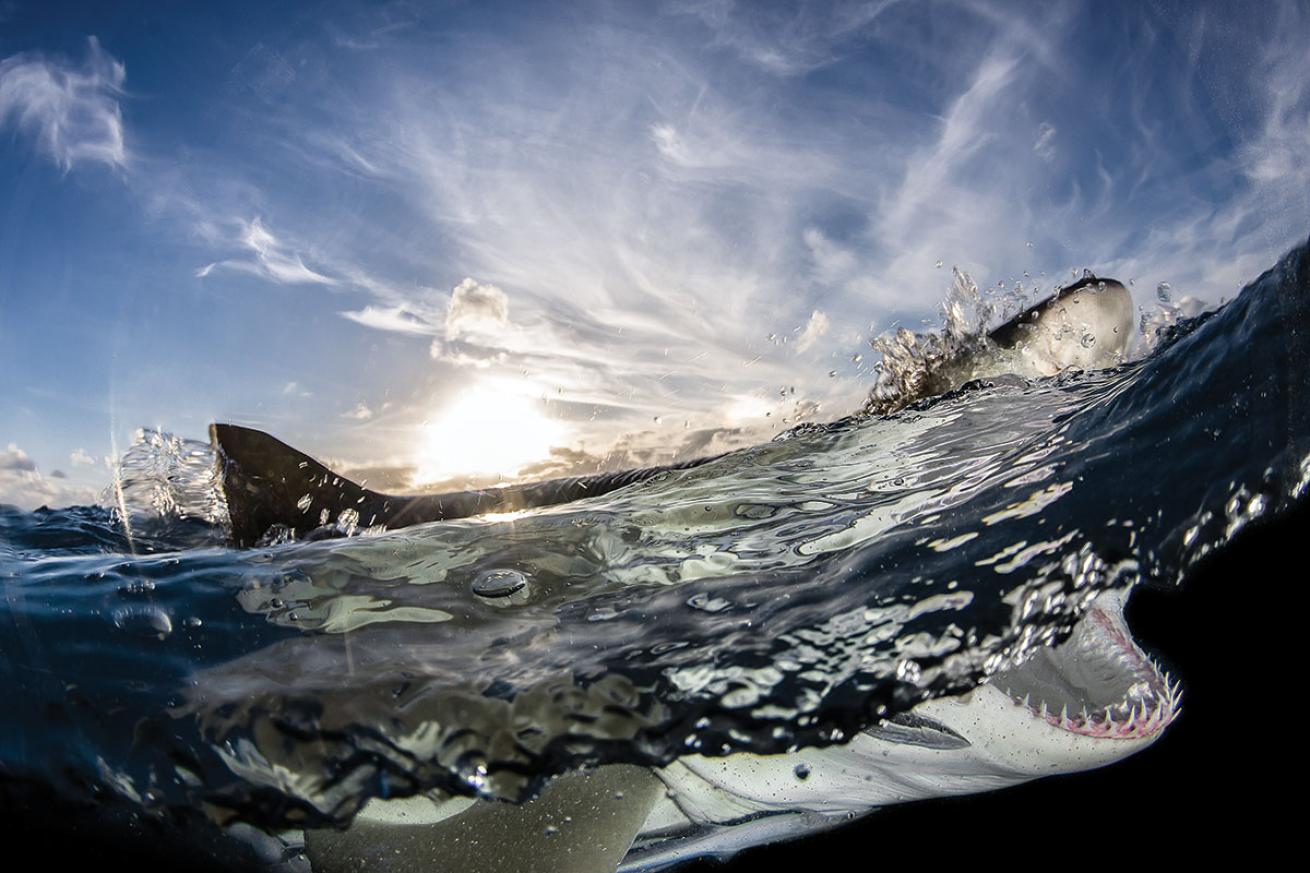
Greg LecoeurThe Bahamas is Shark Central for a number of species, including the lemon, which likes to feed at night.
Go to a restaurant often enough, and you’ll find that sometimes, the chef tinkers with the menu. Chances are it’ll be good, or at least different. A surprise. And so it is with diving. We have our go-to favorite locales, but sometimes we want the guide to take us to a little-visited location. Or a site the crew doesn’t feel comfortable taking just anyone to. Often, it’ll be somewhere near open sea, where strong currents and serious surface swell collide. It’s an ocean wilderness that offers terrific odds of seeing something impressive. Like that unexpected entree, it’s diving that’s not always on the menu. Quite the rush indeed.
GRENADA
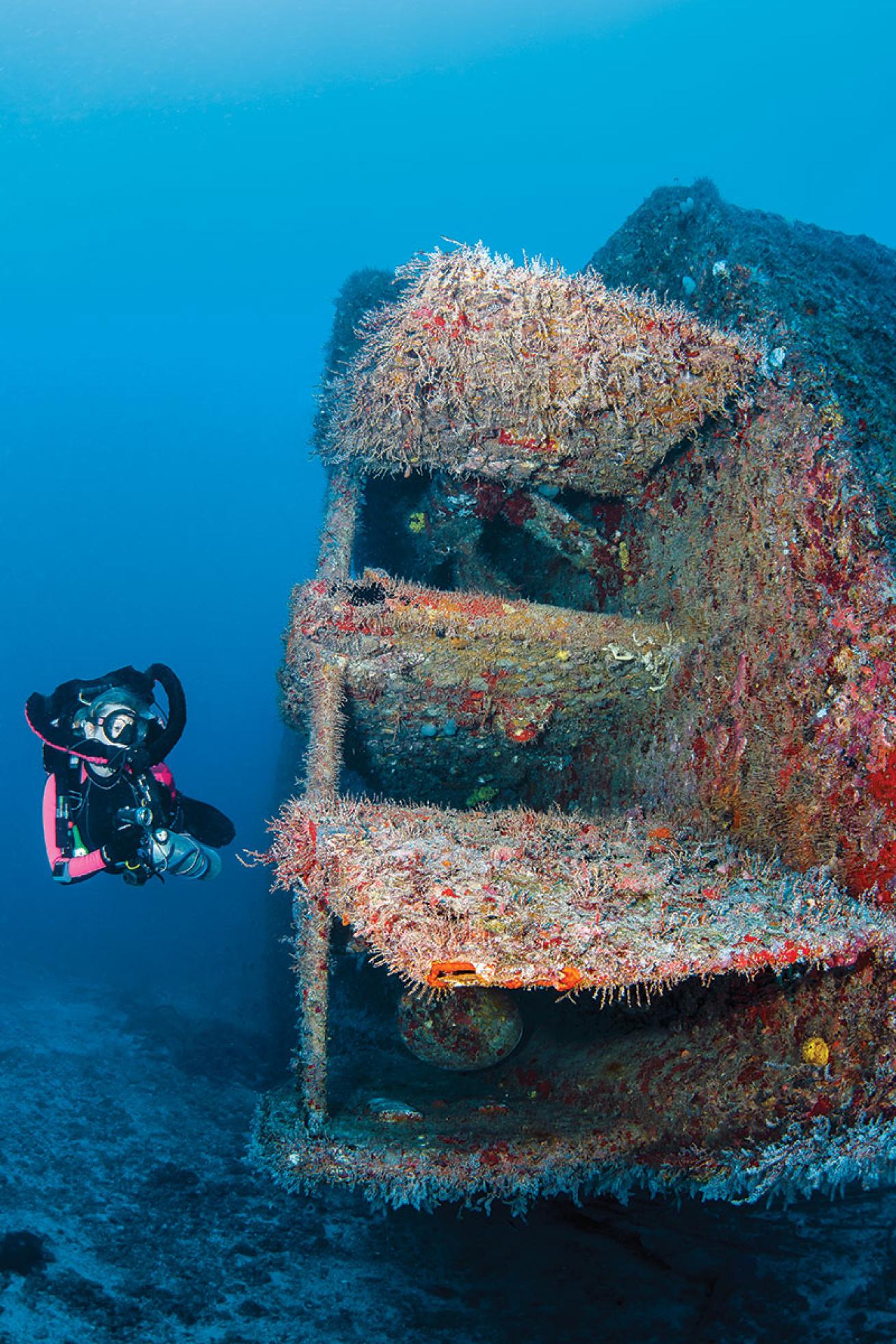
Andrew SallmonWild Side Diving: Grenada
For divers who can handle temperamental seas, the former minesweeper King Mitch offers plenty to explore, including its rudders.
“You go down fighting the whole way,” says Peter Seupel, co-owner of Aquanauts dive shop, of what it’s like to descend into the currents that charge overtop the wreck of the 240-foot King Mitch, 4 miles off Grenada. “You find a place to hold on, and then it’s like a movie theater — you just watch the show.” And that show tends to be eagle rays. “It’s a cleaning station for them, so while you see two or three elsewhere on-island, here you see 20 cruising round you.” The cargo hold, which still contains much of the goods that once caused the vessel to sink, now shelters schools of fish. Also out in the Atlantic is the Hema 1, a cargo vessel that was overloaded, causing it to sink in 110 feet of water. Thanks to a 2005 hurricane, the ship is sliced in two. But Seupel says that’s a benefit. “The current likes to run through that gap between bow and stern, and so do the sharks and eagle rays.”
IN ANY WEATHER The massive M/V Bianca C, a 600-foot former passenger ship, is divable year-round. Although you might not see the bottom when you drop down, you’ll at least be able to do a free descent. aquanautsgrenada.com
U.S. VIRGIN ISLANDS
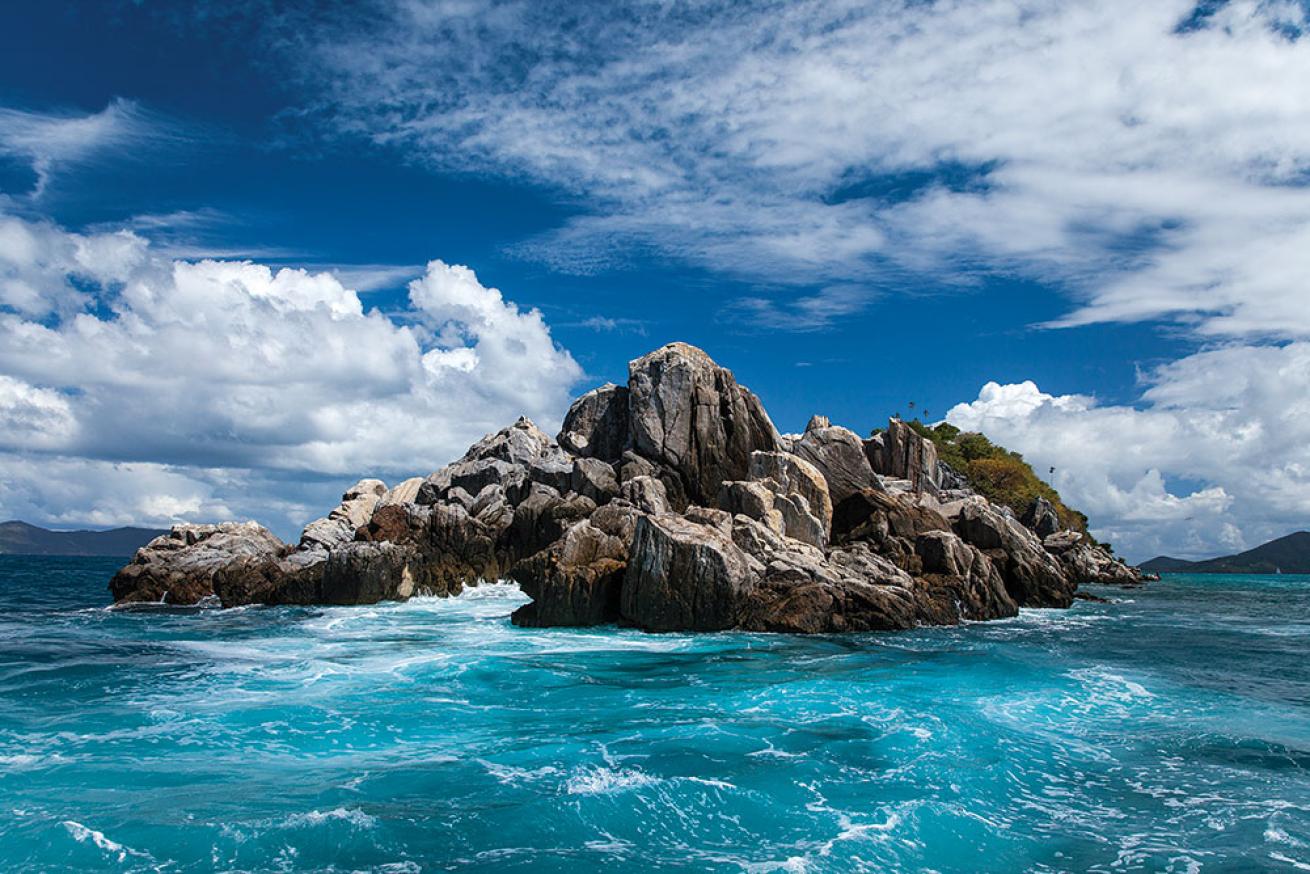
Steve SimonsenWild Side Diving: U.S. Virgin Islands
Sheer cliffs and swell greet divers at Carval Rock, but underwater they are rewarded with tons of fish and coral-covered canyons.
“My most memorable dive on Carval Rock was a day that we had a few cancellations — it was just me and one other diver,” says Travis Krueger, instructor at Red Hook Dive Center on St. Thomas. Krueger says the islet (also spelled Carvel Rock) is the most exciting site visited by his outfit. The sheer-walled formation sits a mile and a half of the island’s north side, smack amid the Atlantic Ocean. “We didn’t swim anywhere, but just sat in one spot and watched hundreds of fish swirling overhead.” The site, due to its location, is best accessed in summer, but if reached in winter is an ideal spot for hearing whale song. Regardless of season, it’s a hot spot for marine life. Says Krueger: “It’s common to see dozens and dozens of tarpon, snapper, schooling jacks and king mackerel feeding.” And while the occasional shark is sighted, the locale isn’t known for pelagics — but did at one time attract much-larger passersby. The rock’s twin peaks resemble sails, or so allegedly thought the pirates who once fixed lanterns on them to lure boats to crash into it. More trivia: Competitors in The Amazing Race 25 climbed across the top of the rock before jumping into the ocean.
In Any Weather Congo Cay is divable year-round because you start the dive on the protected side, then make your way over to the wall. Says Krueger, "You ease into it, but then it's an in-your-face-wall." redhookdivecenter.com
PETIT ST. VINCENT
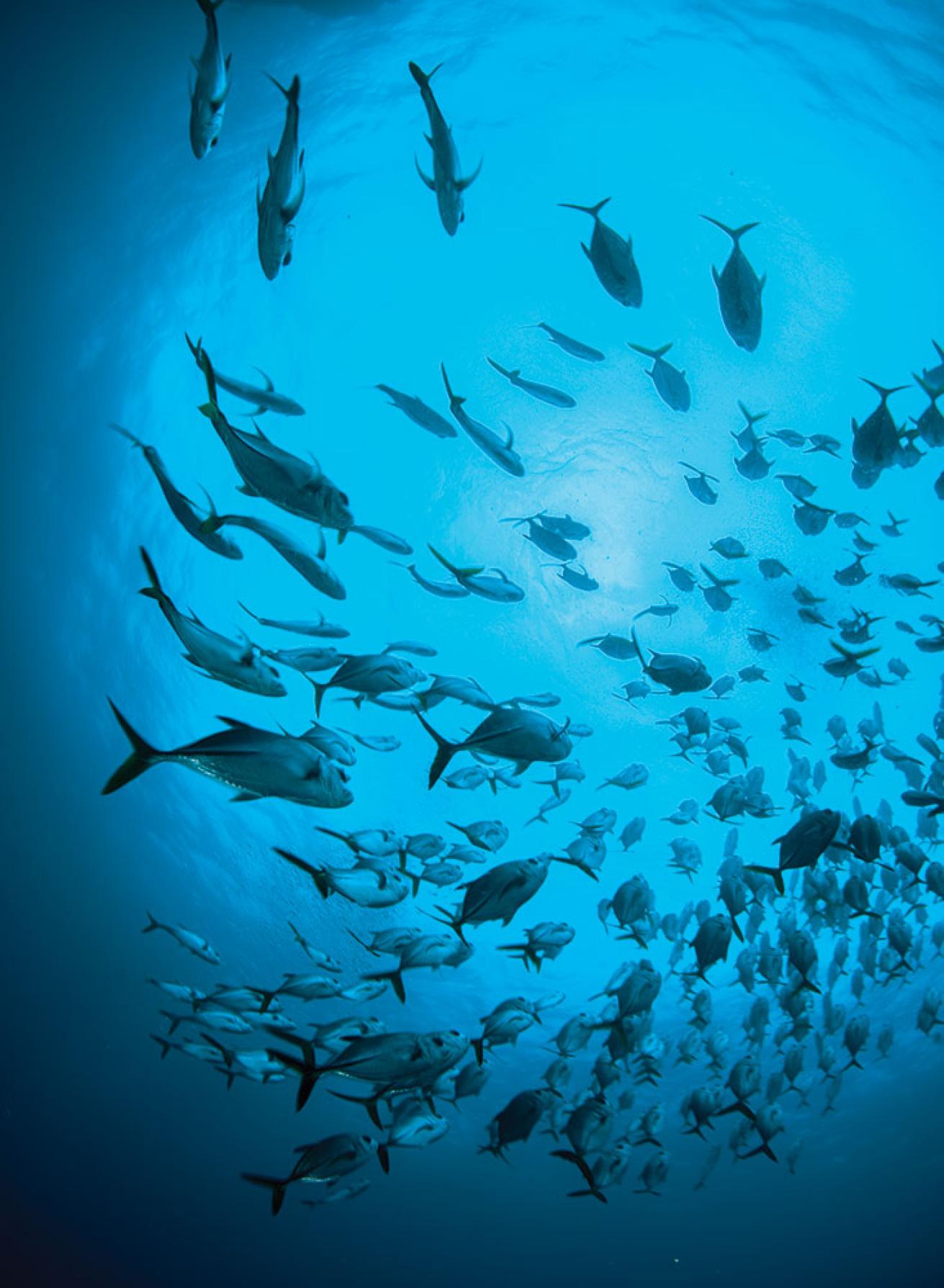
Steve SimonsenWild Side Diving: Petit St. Vincent
Currents that swirl around Sail Rock are a conveyor belt for schools of fish — and a challenge for Divers.
“I saw Sail Rock every time I flew in from Barbados,” says Don Santee, co-owner of Jean-Michel Cousteau Diving Caribbean. He opened the shop this past November on Petit St. Vincent, a privately owned island in the St. Vincent and the Grenadines chain. His first order of business: Scout and explore dive sites. Sail Rock — the exposed feature jutting from the Atlantic along the island’s windward northeast coast — proved most enticing. “There’s so much current that whatever grows there is on a small scale.” That is, except for fish. It’s where Santee has seen the area’s biggest sharks and schools of snapper, and the greatest diversity of color. But it’s also the most challenging site. “The currents carry you laterally, and up and down.” The unpredictable currents don’t deter Santee. “It turned out to be our best site so far,” he says. “Before we set up shop, the other local operators weren’t diving it; now, they all are.”
In Any Weather Santee recommends diving the Tobago Cays and Mayreau Reef, which are also located in the Atlantic but provide more protection from currents. jeanmichelcousteaudiving-caribbean.com
BONAIRE
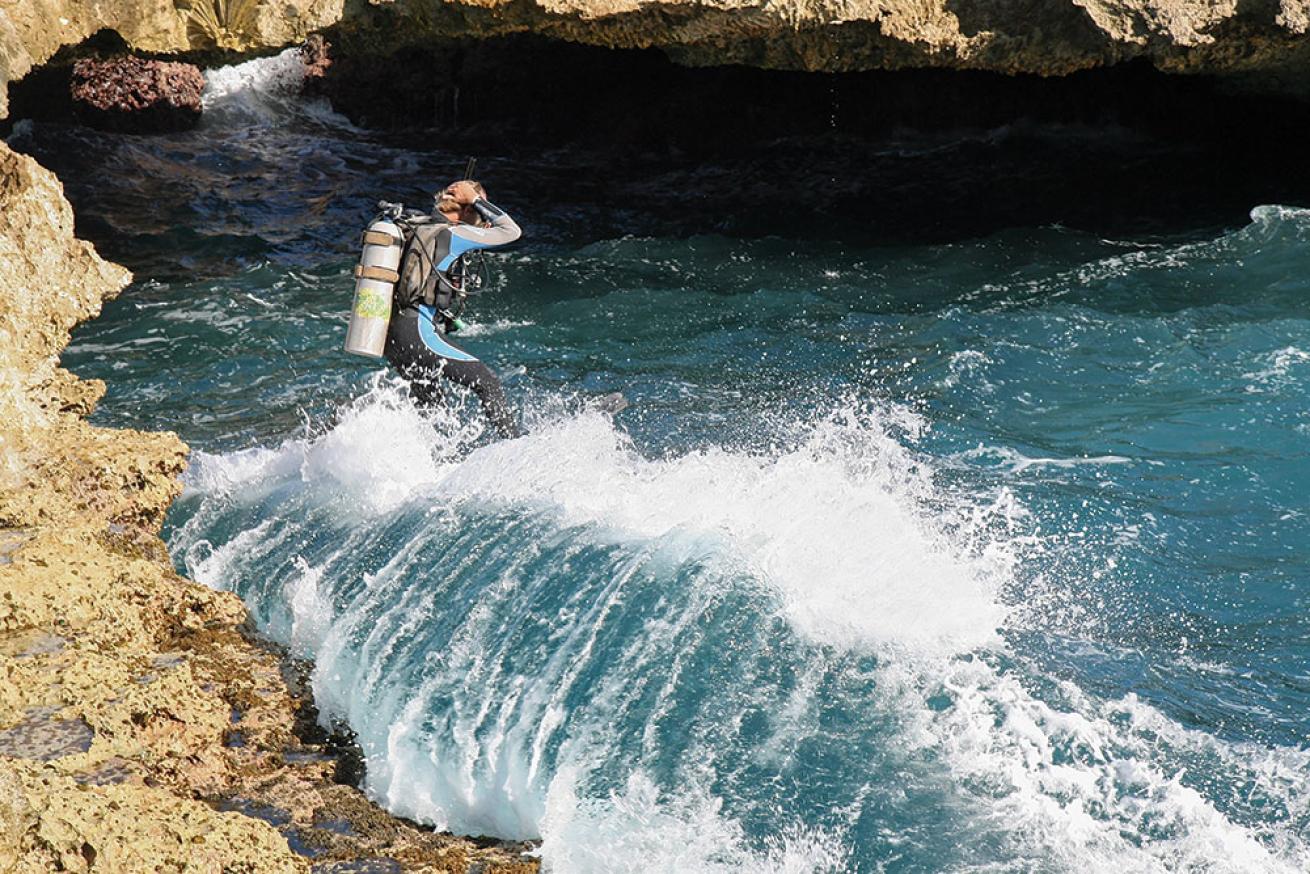
Dirk MuellerWild Side Diving: Bonaire
A boka on Bonaire translates to "mouth"; it is where the sea cuts into the shore. This is a remote boka on the island's east side.
“It looks intimidating from shore,” says Bas Tol, a private dive guide based on Bonaire. He’s talking about a site called Boka Spelonk, found along the elbow of the island’s east side, the opposite coast of where most shore divers park their rental pickups. “The entry is steep ironshore, and people say, ‘How the hell am I going to get in?’” The trick is knowing which rock to crouch behind as crashing waves come in. On the return to shore, this same wave-break creates pools of foam on the surface, adding drama. In between, Tol says you’ll see more turtles than anywhere else on-island. Boka Spelonk also packs species of small stuff not found on the west coast. It adds up to an experience that Tol calls the most exciting on-island. The area can be visited year-round, as long as conditions permit — a constant southeasterly wind blows in, and sometimes the waves are too huge to permit diving. Tol says accessing these sites depends even more on the divers, and their gear. He won’t take someone who doesn’t have good booties and a full wetsuit. Says Tol, “This diving is serious, but when wind picks up, it’s extra serious.”
In Any Weather The wreck of Hilma Hooker, a freighter with a colorful history of illegal drug running, is accessible from shore. Divers may find tarpon and territorial sergeant majors guarding their nests. buddydive.com
COZUMEL
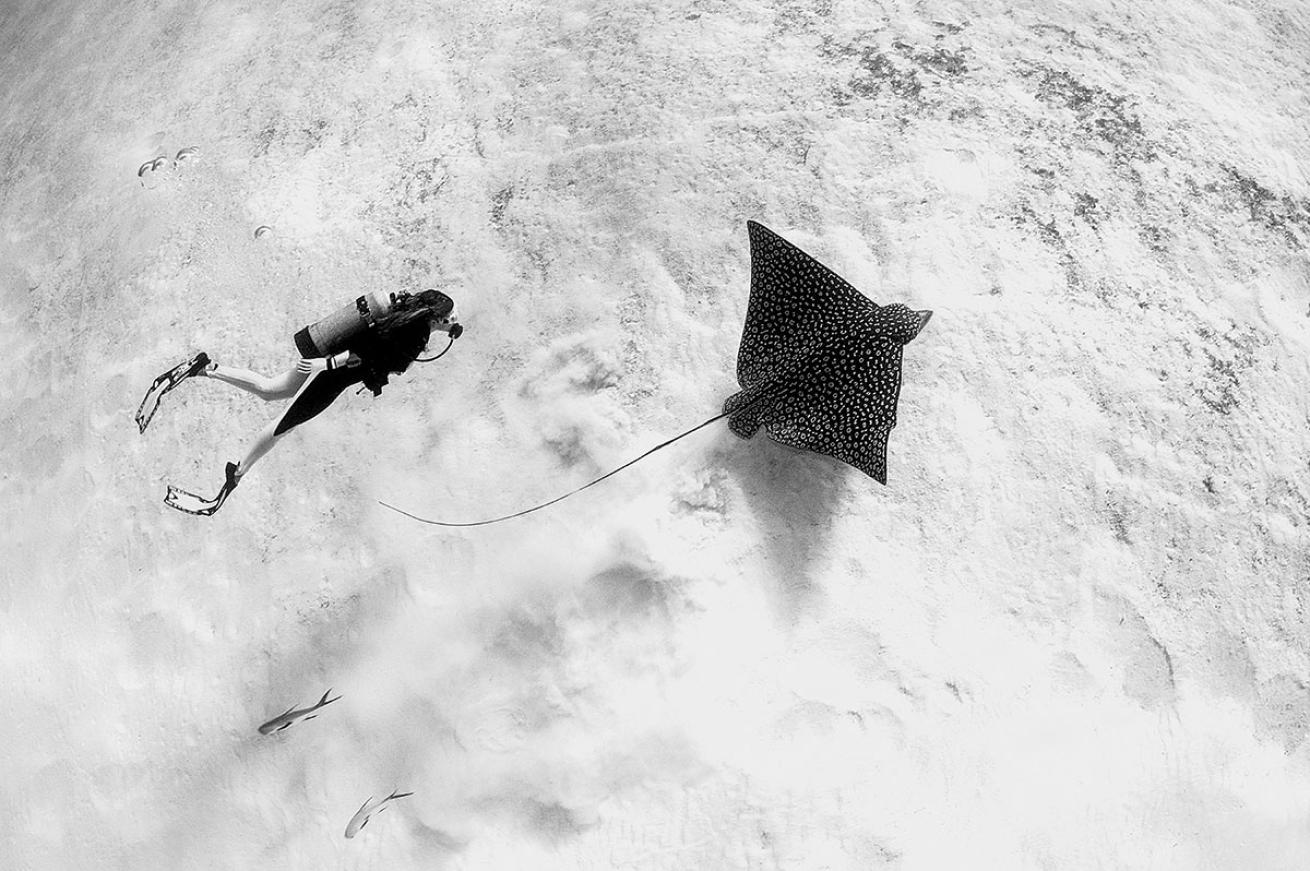
Joe Dovala/Getty ImagesWild Side Diving: Cozumel
Divers ride in small boats tossed by choppy seas to dive Coz's east side — but the payoffs can be huge.
Guillermo Mendoza has spent 25 years diving the island of Cozumel — and the past five looking for an area that’s local legend. Since the mid-’70s, neighboring Isla Mujeres was famous for caves of sleeping Caribbean reef sharks, until an influx of divers scared them of.
“I knew they had resettled somewhere close,” says the co-founder of Aldora Divers. In February 2014, Mendoza found it: six caves, all approximately 6 nautical miles from Cozumel’s northeast tip. “I almost cried,” he says. The caves vary in depth from 80 to 110 feet, and inside, on a good day, Mendoza has laid beside four sharks. “It’s peaceful to watch their gills, and the remoras cleaning their bodies,” he says. The area is reachable only when winds die to less than 10 knots, and waves are no higher than 3 feet. Mendoza says February to June is the best time of year for seeing the greatest number of sharks. In this virgin oceanscape, there’s always a chance of encountering an eagle ray hunting crustaceans.
In Any Weather Aldora Divers specializes in dicing the island's northeast tip, and the eastern side. There, one of the more unique dives is an unidentified Spanish galleon with 17 cannons and countless cannonballs — but good luck finding the ammo. "I hide them after every dive so nobody's tempted to take them off-island," Mendoza says. But he is also quick to uncover them so divers can hold and feel the history contained in just 8 pounds. aldora.com
TOBAGO
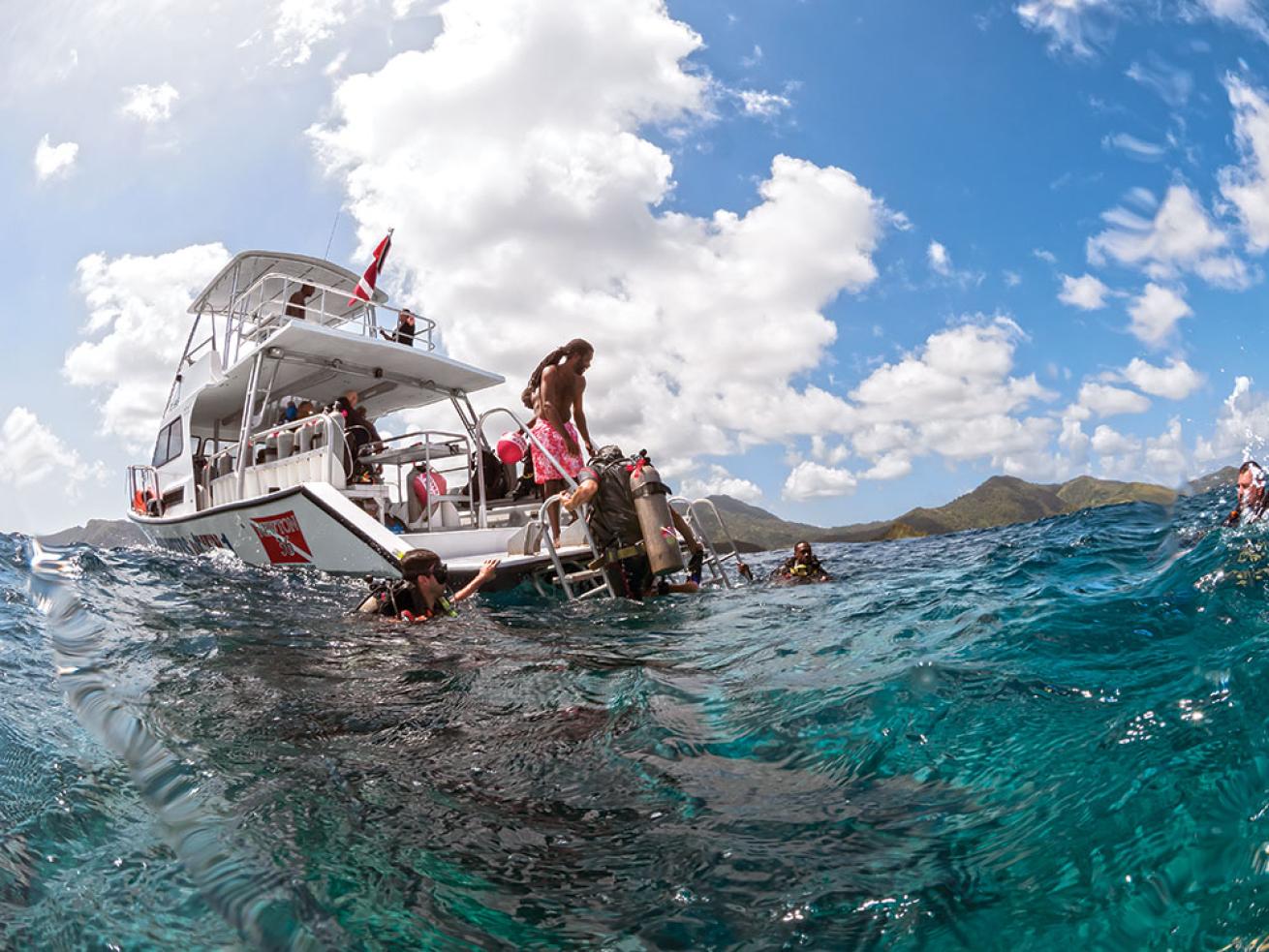
Kadu PinheiroWild Side Diving: Tobago
Divers make their way back on board the boat after diving off Tobago.
On Tobago, there’s a site called Heart Attack, named by a visiting Italian who deemed the reef one of the best adrenaline inducers he’d experienced. “It starts with a negative entry,” says Sean Robinson, owner of Tobago Dive Experience, of the Atlantic Ocean spot. And by that, he means you purge all air from your BC before rolling of the boat into the 4-knot current. “You point your head down, then when you reach the rock formations, you hold on — it’s pretty wild,” he says. The maximum depth is 110 feet, and the area, best visited June through October, is the cruising grounds of everything from mantas to whale sharks. As for the Italian diver, he kept encountering sharks. Says Robinson, “Wherever he turned, a big reef shark was swimming up in his face.”
Another open Atlantic Ocean site that quickens the pulse is called Washing Machine. “The currents form a vortex that spins you around and pulls you down,” says Robinson. “For an experienced diver, it’s the wildest roller coaster that you’ve ever been on, and it’s all fun as long as you don’t panic.”
In Any Weather Dive Shark Bank, and you're following an underwater mountain range from 110 to 50 feet. Says Robinson, "The chances are good you'll see pelagics — there's tremendous marine life." tobagodiveexperience.com
CONCEPTION ISLAND, BAHAMAS
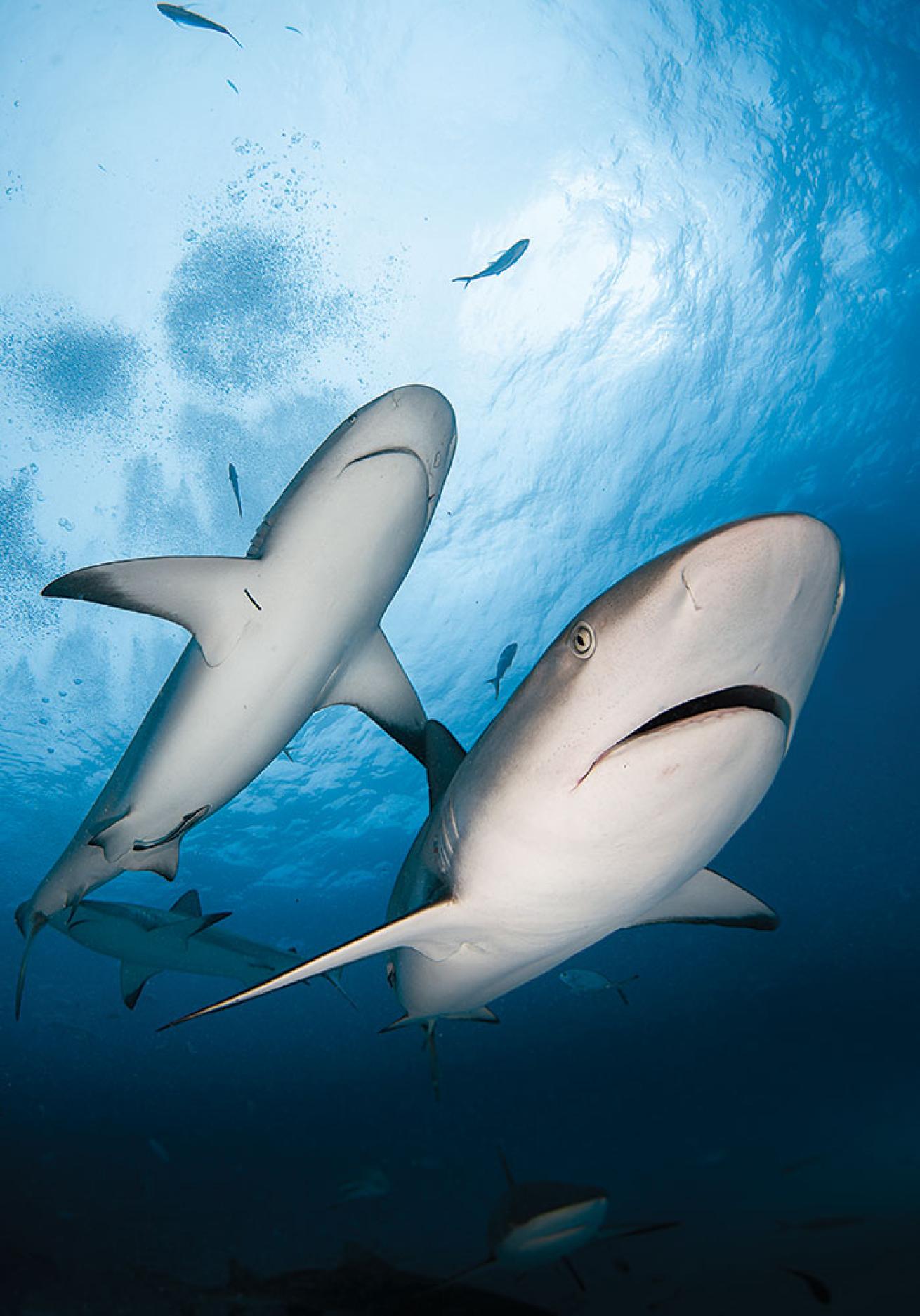
Greg LecoeurWild Side Diving: Conception Island, Bahamas
The Caribbean reef shark (Carcharhinus perezii) is a requiem shark that can grow to 10 feet long.
“We call it Heaven; it’s challenging to get to in that it has to be the right day, right current, right weather to dive,” says Dan Doyle, captain of the R/V Sea Dragon liveaboard, which visits the hard-to-reach south side — the windward side — of Conception Island in the summer months. The Atlantic Ocean site Doyle speaks of is listed on maps as Tunnel Heaven, a drop-of starting at 70 feet. “It’s a series of tunnels that look like teeth,” he says. Inside the tunnels,hulking goliath grouper stand guard. Outside, lucky divers may encounter the odd hammerhead or tiger shark cruising past. As is true throughout the Bahamas, “you see Caribbean reef sharks any time you want to dive the site,” says Doyle. Another plus: The island’s center is a large mangrove and creek habitat, which serves as an important nursery for fish. The island enjoys another advantage: “The marine life gets so much bigger because commercial fishermen don’t reach these areas,” says Doyle. That marine life includes sponges of gigantic proportions, and pristine black corals and sea fans.
In Any Weather If you can't dive the south wall, you can put in along the island's shallower western wall, where the corals grow much bigger and the visibility can exceed 100 feet or greater. seadragonbahamas.com
BRITISH VIRGIN ISLANDS
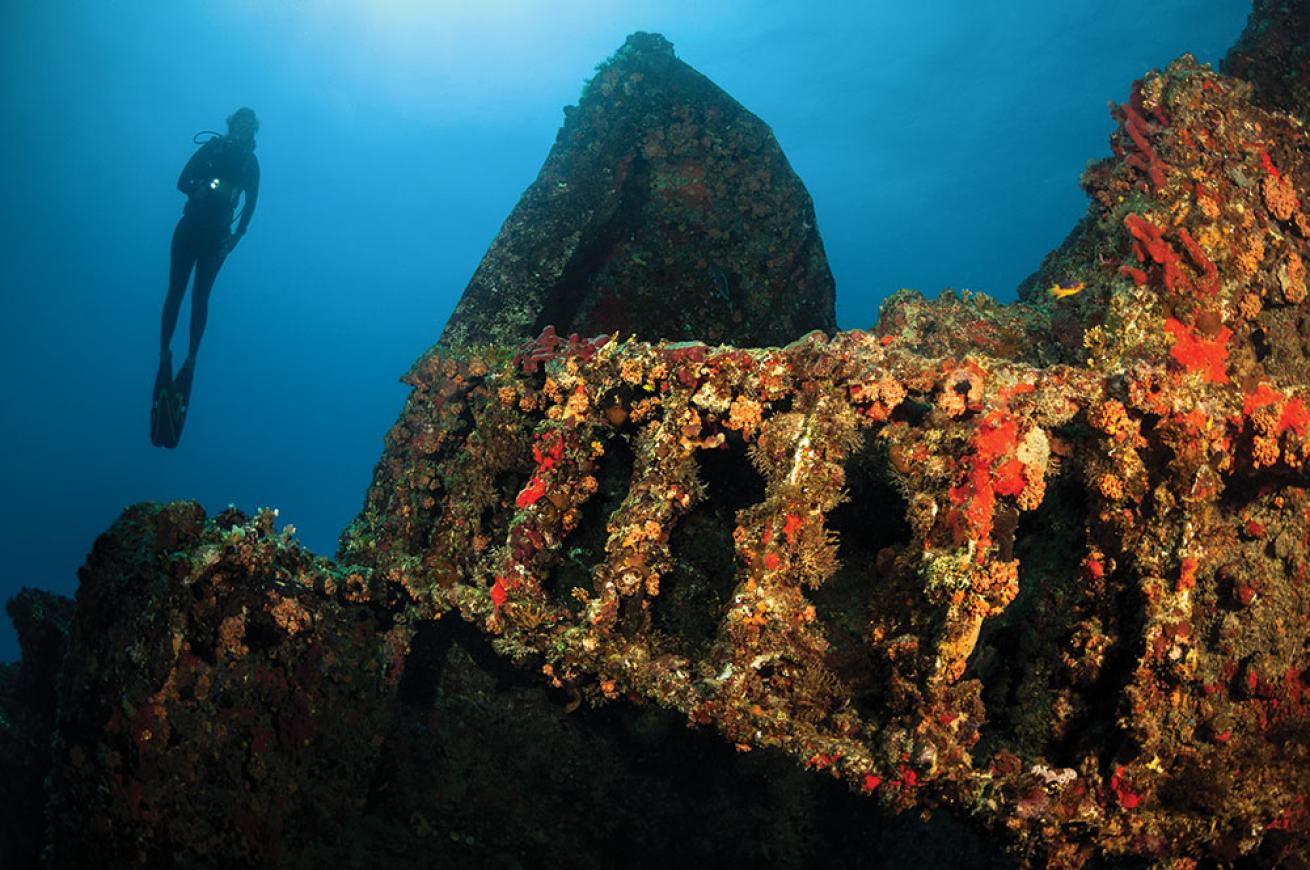
Jason BradleyWild Side Diving: British Virgin Islands
Weather often prevents dive boats from getting to the Chikuzen, but dives here are worth the trip.
“The best dive in the whole British Virgin Islands isn’t the Rhone, but the Chikuzen,” says Duncan Muirhead, owner of the S/Y Cuan Law, a trimaran customized for weeklong dive trips in the Caribbean island chain. The Chikuzen, a 246-foot former refrigeration ship, lies roughly 10 miles northeast of Virgin Gorda and is best reached in summer months. “It’s such a good dive site because it’s surrounded by sand desert — it’s the only habitat for miles,” Muirhead says. Nurse sharks, schools of amberjack, and cobia take notice, swirling constantly overtop the upright structure. “There’s a huge number of great barracuda behaving like a school, pointing the same direction like one, big silver wall,” says Muirhead. For big pelagic traffic, Muirhead also likes a site called the Invisibles, just north of Virgin Gorda’s eastern tip: It’s a current-swept, twin-rock pinnacle that rises within 4 feet of the surface. The site gets its name because operators look for breaking waves to reveal the formation’s location. Says Muirhead, “It’s so great to dive because there’s nothing between you and Africa.”
In Any Weather The RMS Rhone off Salt Island is undoubtedly the best-known local dive: It packs swim-throughs, artifacts and intact structure. But few visitors see it at night, when monster lobsters run wild. cuanlaw.com
Mr. Diver's Wild Ride
To access these sites, you'll make a roller-coaster sea crossing — but the rewards are worth it.
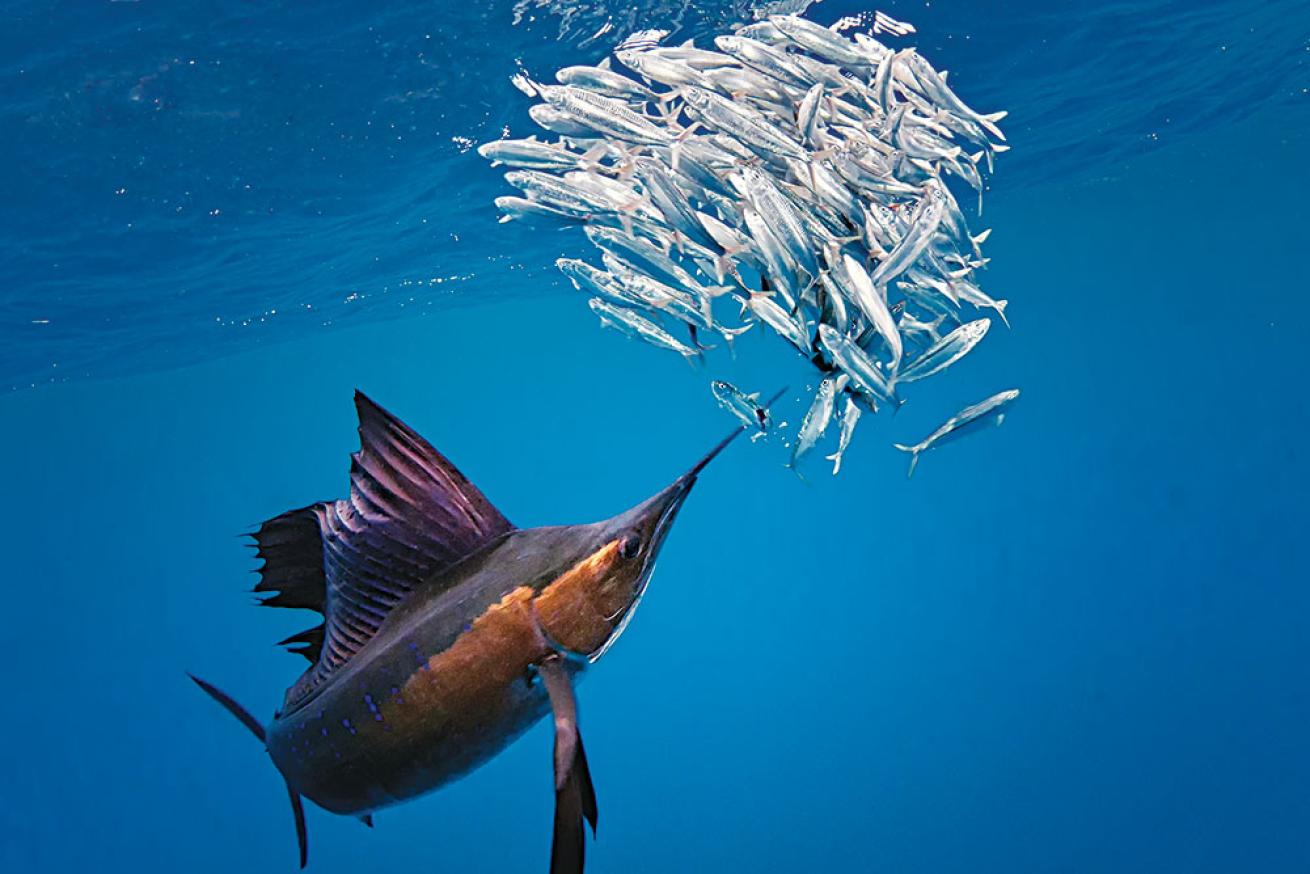
Peter AllinsonSailfish off the coast of Mexico
Mona Island, Puerto Rico
Land-based dive operators make only rare, special trips to Mona, on Puerto Rico’s wild western side. It’s a 45-mile ride to reach this remote ecological reserve where the Atlantic and Caribbean mix it up. Be prepared for rough seas with swells, hold-onto- your-reg currents, house-size coral heads, and shark, humpback whale, turtle, and dolphin encounters. gotopuertorico.com
Isla Mujeres, Mexico
Life-and-death scenarios play out from January to March every year in the clear waters of Mexico’s Isla Mujeres, an island about 8 miles from the Yucatan coast: Schooling sardines attract hunting Atlantic sailfish with few table manners. Guides look for frigate birds dive-bombing the baitball, and then you plunge in for the photo op of a lifetime. prodivemex.com
Gladden Spit, Belize
During the full moon from March through June, spawning snapper aggregations at Gladden Spit of southern Belize entice whale sharks to this open-ocean reserve. It’s an hour-long boat ride over stomach-churning ocean, a fast descent to 60 feet, and serious finning to follow your guide — but what a payoff when the sharks join the party. splashbelize.com

